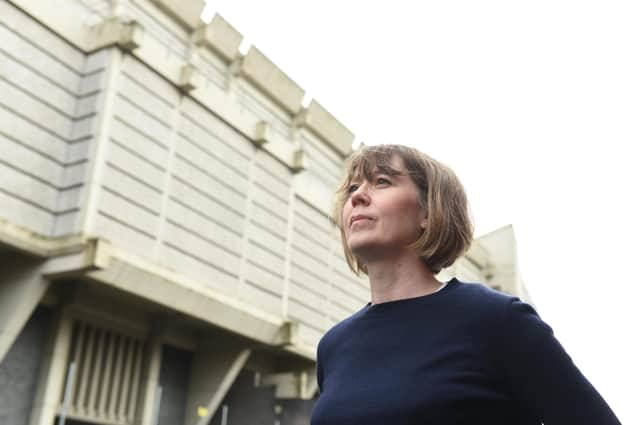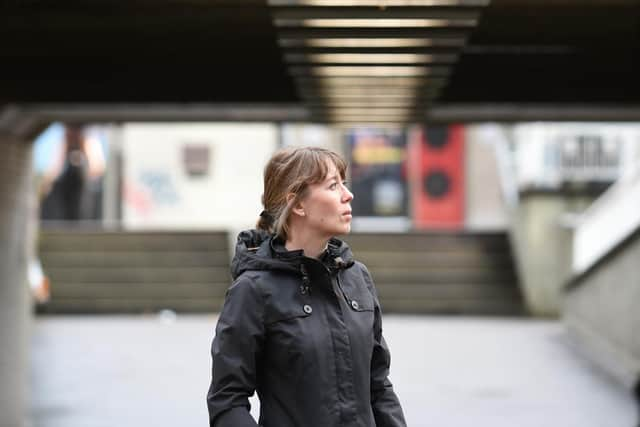What's special about concrete? Meet the Sheffield society championing modernist buildings


For those of us of a certain age, this comes as something of a shock. With their flat roofs, rain-stained concrete walls and jarring angles, modernist buildings seemed to be the epitome of what people didn't like about the Sixties and Seventies. Indeed, the most extreme of these concrete creations acquired the name 'brutalist'. Yet in recent years a strange turnabout has happened: there are growing calls for such buildings' preservation. But can we learn to love tower blocks, concrete slabs and glass civic centres? I met a pro-modernist campaigner to find out.
Helen Angell is coordinator of Sheffield Modernist Society, a role she shares with photographer Sean Madner. This is the Yorkshire branch of a wider national organisation which seeks to promote and preserve modernism. Helen's cheerful enthusiasm is what immediately strikes me. I ask her: why modernism? What's so special about concrete? She laughs at my incredulity.
Advertisement
Hide AdAdvertisement
Hide Ad“I've always loved it from being a toddler! So probably it's got a lot to do with childhood associations. I grew up in Rotherham and my Nan was a cleaner in the incredibly brutalist civic centre. On Fridays we'd go to the wonderful modernist library with Granddad. It was all part of a marvellous civic complex that included a theatre, art gallery and so on. Then for the last hour or so of Nan's shift I'd help her clean the civic centre.


“That library had sliding doors, smoked glass, split levels – it was amazing architecture! Of course they knocked it down to build a supermarket and the replacement civic centre has none of the magic of the one I remember. The modernist one was next to a fabulous concrete walk-over – now demolished – and big blocks of flats – now demolished – and I feel the loss to this day. To me, much of the identity of Rotherham and Sheffield is tied up in architecture like this. Fortunately a lot of it remains. Rotherham still has its modernist market, it still has the C&A building which is now the Halifax. All this needs protection. Our group aims to champion the legacy of modernism here and across the whole of Yorkshire, to make sure this inheritance isn't lost forever.”
But childhood memories aren't the only things inspiring Helen. “As a teenager I became very interested in all the arts. I loved anything with clean lines. I remember reading lots about modern artists, writers and poets. I loved art deco with its stylish simplicity. I became a great fan of houses from the 1930s with flat roofs and the distinctive window styles of that period. But post-war brutalism became my main love! People don't realise this, but it's full of wit and humour. It's outrageously playful and futuristic. I love the experimentation, the boldness ...”
We discuss Helen's favourite buildings in Yorkshire. She tells me our region possesses many nationally important examples of modernist design, from wonderful Thirties houses tucked away in Ilkley, Bingley and Huddersfield, to distinctive glass towers like the Arts Tower at the University of Sheffield. Then there is Sheffield's unique collection of modernist churches. Helen's favourite is High Point, the Yorkshire Building Society's former HQ up the road in Bradford. To many, it's a slab of grooved concrete which looks like a rather forbidding fortress. “It's big and bold,” enthuses Helen. “It was fantastically prestigious in its time! And it gives off an air of permanence and security, no different to what the Victorians aimed for when designing their banks.” I have to agree with her, a building like that definitely makes an audacious statement as it towers over its surroundings. I realise I could be won over by Helen's point of view.
Advertisement
Hide AdAdvertisement
Hide AdBut there are some questions I need answering first. I ask Helen if she appreciates things that are widely thought of as picturesque? Does she also like traditional, ornate buildings? In other words, can you be a modernist and a traditionalist at the same time? Again, Helen smiles at my naivety. “I just like beauty,” she replies. “The west front of Chartres cathedral is a wonderful thing. All kinds of things can be beautiful; but I have passion for modern design, for its simplicity. Modernism has a progressive nature, it points to the future, it's sophisticated and dynamic. It fits into a city just as much as a cathedral does.


“Modern buildings have this reputation of not being in harmony with their landscape, but that's very unfair. Look at Park Hill, Sheffield's iconic flats from the Sixties. They fit perfectly onto their hillside, and they're angled so the views across the city and countryside are fantastic. They have uniform roof levels, they have linking bridges. They couldn't be anywhere else – they're exactly fitted to their environment.”
I see her point. But surely winning over the wider public might prove a big challenge? Helen's reply is unequivocal. “People said that about Victorian buildings once. Back in the Fifties and Sixties their popularity was at rock bottom, and local councils were pulling Victorian stuff down all over the place. Many important building were lost. It took a big effort to get people to understand that it might all soon be gone. But campaigners did manage to turn the tide.” Helen laughs optimistically. “We aim to do the same for modernism!”
The optimism might not be misplaced. The last five years or so have seen a boom in interest in modernism and brutalism. A spate of books have appeared and online interest has burgeoned. Enthusiasts across the country are mobilising their campaigning forces. The writer and presenter Jonathan Meades and Smiths guitarist Johnny Marr have become patrons of the Modernist Society. And, despite losing some important buildings, there have been success stories. Across the Pennines, Preston bus station is probably the iconic brutalist building whose rescue from the wrecking ball has given the campaign hope. Saving Derby's concrete Assembly Rooms is now high on the agenda.
Advertisement
Hide AdAdvertisement
Hide AdBut for Helen it isn't all about campaigning. As the country emerges from lockdown she's planning some trips to places which are considered iconic in the modernist movement. She smiles as she explains. “Along with other aficionados of concrete and brutalism, I pack my sandwiches and we head off to Sixties developments all over the north and beyond. We go to Skelmersdale and Cumbernauld, places like that. We go to see the things we admire: integrated housing, split level designs, flyovers, subways with marvellous concrete reliefs or maybe even the original tiles. We make notes, take photos, and I write poems based on what I see. The creative inspiration I get from modernism is a massive thing for me. Modernism is my muse!”
So maybe change is in the air. Maybe concrete and glass will gain that public affection which so long eluded it. Having met Helen Angell, I must confess to being a bit of a convert, and I'm certainly not the only one. When it comes to deciding what to preserve, bold, brutalist architecture, with all its futurism and flaws, could be the new kid on the block.
Pictures by LAURA PAGE